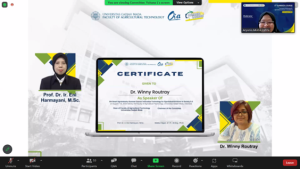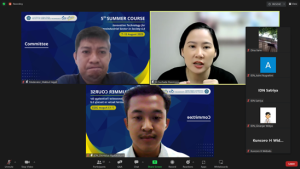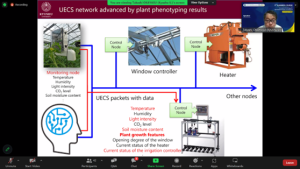
The 5th Summer Course’s second day held on Tuesday, August 8th, 2023. The first session was opened by Dr.Eng. Herianto, S.T., M.Eng., IPU., ASEAN Eng. from Faculty of Engineering, Universitas Gadjah Mada as a national speaker. The main topic of the speaker is 3D Printing for Chocolate. The process of 3D printing is made layer by layer or additive manufacturing. 3D printing is started with a CAD model and then transformed into a 3D object in some steps and techniques. The participants were so enthusiastic and it showed in a question-and-answer session. The participant and the speaker discussed the 3D food printing treatment if there are any characteristics. The speaker talked more about the treatment of 3D food printing according to the material, compounds. It brings a different process, different material, so different machines to create the 3D printing product. The conclusion from Mr. Herianto is that the technology of food printing can represent a remarkable innovation because the potential of the technology can revolutionize various aspects of the culinary and food industry and also can anticipate a future where it has a pivotal role in producing, consuming, and experiencing food.
After the first session, the participants joined the breakout room to discuss with their group. The topic of discussion is commodity or industry and gives ideas of technology innovation that can bring up and push the agroindustrial sector in society 5.0. All the participants were divided into 12 groups. All groups have approximately 30 minutes to discuss and brainstorm their topic. In this discussion session, the participants can develop their analytical thinking skills to brainstorm and analyze the idea from the perspective of its strengths, weaknesses, opportunities, and threats of the technology.
The series on the second day of the 5th Summer Course is continued by the second session speaker from Dr. Winny Routray from National Institute of Technology of Rourkela. The main topic discussed in this session is food engineering and post-harvest processing of spices. This topic is talked about spices, which is a product that has a lot of functions such as adding flavor and scents to foods. The product is made from spices such as essential oil. The highest exporters of spices are India, Vietnam, China, Indonesia, and Madagascar, while the highest importers of spices are USA, Germany, and Vietnam. Another important part of optimizing spices products is the packaging. The packaging must consider moisture, oxygen, aroma loss, hygroscopic in nature, pest attack, and weeds in the rainy season. The packaging may contain polyethylene linen and double gunny for bulk packaging. To sustain the production of the spice in the field, some toxins can affect the product such as mycotoxin (ochratoxin), and factors from pre-harvesting, harvesting, and post-harvesting. The solution by the advanced processing method of whole spices, spices powder, and paste such are the drying process using microwave and sterilization process using gamma rays, hydrostatic high pressure, and low-pressure cold plasma. This second session is closed by the certificate submission documentation with the speaker.

The lecture was continued by Dr. Suchada Rianmora from SIIT, Thammasat University, Thailand. The main topic in this session is the product design approach for the agroindustrial sector. The speaker explained that the key considerations of product design and development are to set up “the reference” situation, identify “key components or objects”, and create “a conceptual design” by starting a new journey of product design and development. Also, the participants have new insight and knowledge about developing products and minimizing the gap between high technology and the user in reality. In the processes to develop product design, there are some tools and equipment that can be used such as robots, remodifying and development, and supporting customer satisfaction. Implementation in reality we can do a site survey to take examples and find the case studies. The conclusion in this topic is we should understand and know what the customer needs or should be customer-centric. After that, some participants offered some questions to be discussed with Dr. Suchada Rianmora. All of the elaboration from the speaker gives more perception to the participants.

The last session on the second day of the 5th Summer Course was filled by Prof. Takashi Okayasu, Ph.D. from the Department of Agroenvironmental Science, Faculty of Agriculture Kyushu University. The main topic is talked about plant phenotyping technology to promote data-driven agriculture. Moreover, this topic is UECS network advanced by plant phenotyping results which are correlated between the monitoring node (temperature, humidity, light intensity, CO2 level, and soil moisture content) and plant phenotyping sensor node (image analysis). The system also has connections with a window controller, heater, and irrigation controller. Each connection has a control node and was integrated.

At the end of this day, all the participants do the post-test at UGM’s E-Learning system (e-LOK). Then, the participants can continue the discussion with their group work and do independent study such as material review on this day and essay writing submission. They have to prepare for the third day and always check all of the assignments at e-LOK.
